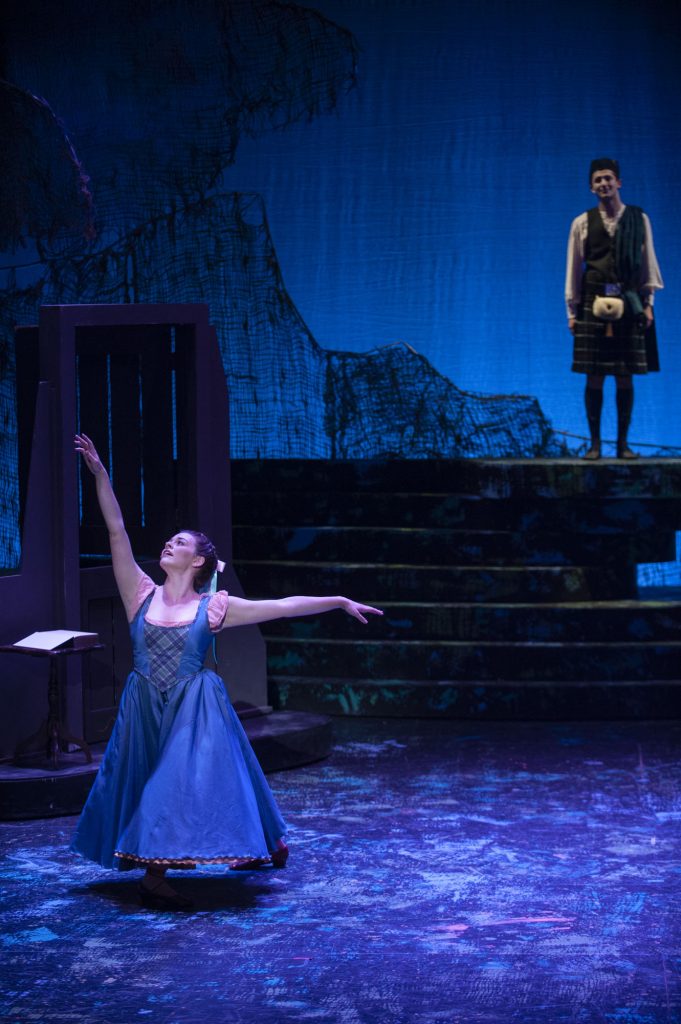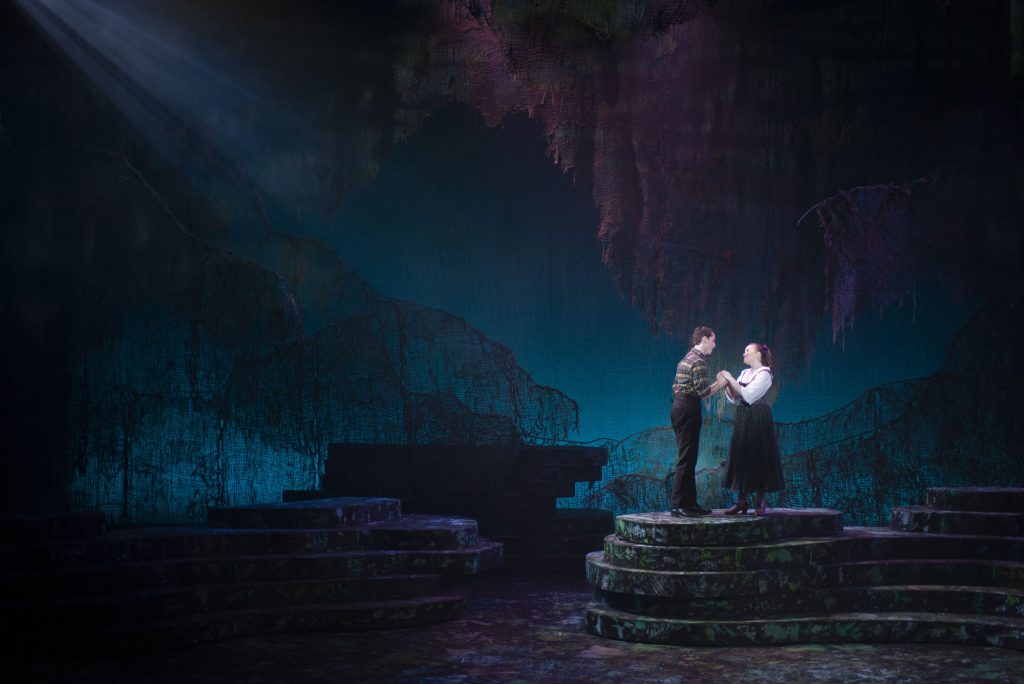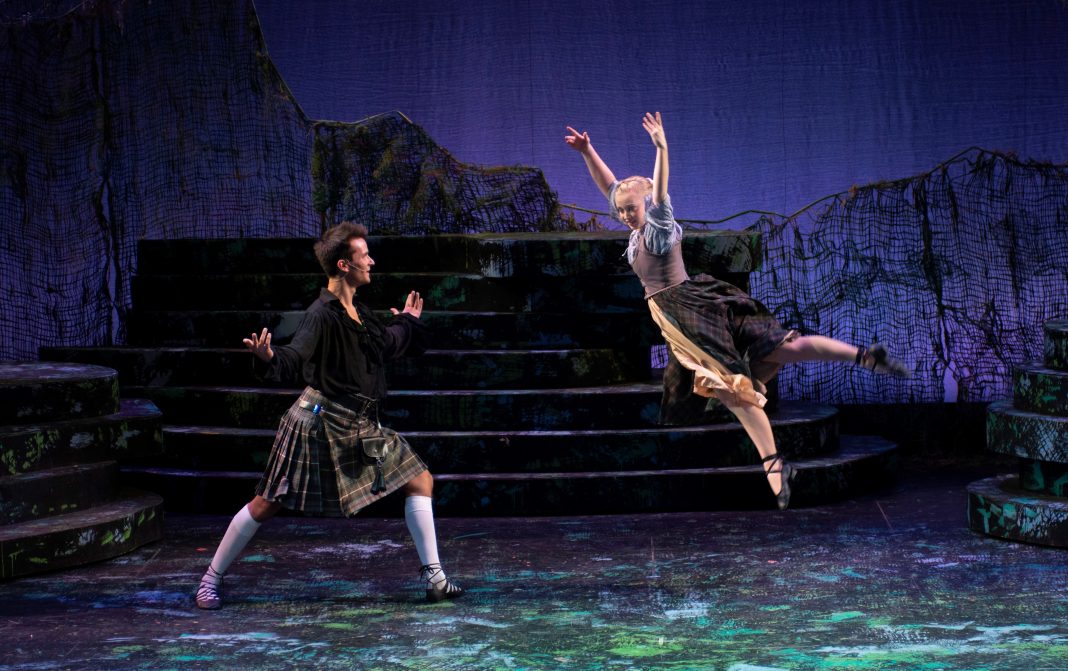Lerner and Loewe’s classic musical Brigadoon, which ran on the Empie stage from Oct. 26 to Nov. 4, is a piece about time in more ways than one. In and of itself, the show is mostly set in the Scottish Highlands as preserved from the 1700s, complete with tartan kilts, colorful corsets and rich local traditions that have since been lost to the ages. Everything from market fairs to extravagant weddings with representatives from different clans proudly marching under their group’s crest are presented on stage in all their glory, allowing the audience to share in the joyful particularity of the writers’ quaint, constructed small-town Scotland.
But this musical is also about the time in which these writers crafted it: the 1940s, the “golden age” of Broadway shows, an age full of uniquely beautiful, expressive dance and ringing melodies made to make the most of a wide range of highly skilled voices. Tommy and Jeff (Julian Mone ’19 and John Caposcale ’22, respectively), the two American characters from the 20th century, stumble upon the Scottish village of Brigadoon and eventually discover its mystical origins – the town is protected from attacking witches and sorcerers by appearing once every hundred years, a miracle ordained by God with the sacrifice of the town’s minister, the price of which is that no one from Brigadoon may leave without the rest of the town disappearing forever. We the audience investigate along with them, noticing Brigadoon’s oddities and falling for its charms much as the characters themselves do.
Still, Brigadoon the musical is a bit like the village itself. In a contemporary context, the audience becomes Tommy and Jeff, modern passers-by who stumble into the show itself, a living, breathing window into what once was: the mid-20th century mindset which lives on through the production itself. In some ways, this blast from the past is welcome. The dancing is stunning; extended, delicate pieces meant only for the dance ensemble and featured dancers (originally choreographed by the legendary Agnes DeMille) are scarcely found in contemporary musical theatre. Even more rare are characters who speak almost exclusively through the medium of dance, like Heather Dutton ‘20’s character Jean MacLaren.

“[Jean] is 18 years old and the whole show takes place on the day of her wedding. My rehearsal process included many separate rehearsals for scene work and choreography,” said Dutton. “One thing that I really love about this show is that dance is constantly being used to develop the story further. While I think it is common to see dance being used in theatre strictly for entertainment, Brigadoon is an example of a show that truly uses dance as another mode of expression. When the characters are feeling something with unfathomable intensity, instead of attempting to communicate it through words, they communicate it through movement. I believe that the way movement is utilized in this show adds a lot to the overall impact it has on people; it is for more than just the aesthetic value, it deepens the story’s emotional life and reveals layers of the characters’ personalities and relationships with one another throughout the show.”
Some of the most poignant moments in Brigadoon are these passionate dances choreographed by Muhlenberg dance professor Karen Dearborn – some moments left my jaw on the floor in awe, specifically the Funeral Dance performed by Emily Forster ’20, a heart-wrenching piece in which Forster’s character Maggie Anderson, having lost her unrequited love Harry Beaton, throws herself upon the ground and at her beloved’s body, undulating in repetitive, outreaching movements that dare anyone in the watching crowd to question her grief and sorrow. In life, her adored Harry, played by Tommy Gedrich ’21, is also quite the dancer. Though angry in words, he is graceful in movement, exquisitely pirouetting and skillfully leaping around crossed swords in a kind of ritual jig.
In one breathtaking scene, Dutton performs a duet of sorts with Adam Cantor ’21, who plays her intended, Charlie Dalrymple. In this classic song, “Come to Me, Bend to Me,” Cantor begins by singing a refrain of love in anticipation of his character’s upcoming wedding. Dutton’s reply, rather than a companion melody, takes form in a ballet dance, a lovely, embodied expression of care and excitement that conveys her reciprocation of Cantor’s words. Her movement is set up as equal to his song, and the piece ends with both of them performing at once, Cantor’s clear voice becoming Dutton’s accompaniment as she and the dance ensemble float about the stage.
“The choreography was all motivated by the story; Karen [Dearborn] was very aware of where we were in the plot throughout the entire process, so each piece of choreography had a very clear point of inspiration,” said Dutton. “Finding a way to truly allow my movement to be emotionally driven was simultaneously the most exciting and most challenging part of this process for me. Most of my movement was very balletic, so it was easy for me to get caught up in the technical execution of the steps and neglect the story-telling elements of the choreography … I have had very few opportunities, especially as a ballet dancer, to do work that was so overtly emotional and expressive. I think my very favorite thing about playing this character was that I got to use movement to communicate with the audience and say things that I don’t think words or music could have said alone.”
Still, despite the show’s artistic beauty, its mid-century message leaves much to be desired. Women in the show are either going to be married or will do almost anything with the eventual goal of getting married, and the men in their lives are equally willing to do almost anything to get the women they want – in one scene, Gedrich’s character Harry assaults Dutton’s character Jean during her wedding ceremony, pinning her down and kissing her in the middle of a dance. As Jean, in tears, is rushed back to her new husband, Harry shouts, “All I ever did was love you too much!” as he runs away with the intent to leave the town. The men gather and chase after him, not because of what he just did to Jean, but because his leaving would condemn them all to disappear as per the rules of the miracle. When Harry dies during the chase, his wrongs are never again mentioned. Earlier in the show, a Brigadoon woman named Meg Brockie (Jessie Kuehne’ 21) makes it clear that she intends to become romantically and sexually involved with the American Jeff, whether he wants the same or not. When he falls asleep after consistently rebuffing her advances, Meg insinuates that she will initiate this involvement while he lies unconscious in a scene that is meant to be read as comedic.

“Brigadoon had some really beautiful moments. The dancing was gorgeous and so was a lot of the music,” said one audience member. “Brigadoon is really antiquated at this point. Some of the story lines and jokes just felt stale and uncomfortable … I really think everybody in the show did their part to make the production as beautiful as possible … I appreciate it as a postwar escapist thing, but I don’t think the couple of sexual assaults the audience witnessed in the show translate to today’s definition of escapism, if that makes any sense. Brigadoon is a nice idea, but if it was far-fetched in the 40s, it’s certainly far-fetched now.”
The creative team behind Brigadoon, the actors, designers and directors who put hours of work into crafting this production, certainly did everything they could to make this show accessible to a current audience, even changing up some of the derogatory language used to describe witches in the original script to mitigate some of the show’s original outright misogyny. The problem, though, lies within the show itself.
“I’d like to see the department take on more modern material,” said the same audience member. “We can recognize that golden age musicals were great in their time without rehashing them and their old fashioned politics.”
Still, perhaps there’s still a way to take something valuable from even a somewhat outdated show. As another audience member, Val Weisler ‘20, said, “I thought Brigadoon was an interesting piece of theatre to watch right now. At first glance, it’s a scenario so far away from our lives as students. But I understood the fear of the people of Brigadoon – the idea that staying in a place for more than one day will cause you to be an active victim in the terror of that century is one I related to quite strongly. They craved this assurance of safety and security that you can’t get when you live day by day, especially in our current political climate.”
This is how we can take the beloved artistic endeavors of old into the future with us: by appreciating their essence, their abstract ideals, and not by reproducing the stories that have already been told time and time again. As Dutton puts it:
“I think that this is a piece of theatre that, when put in conversation with today’s world, encourages people to see beyond themselves. Brigadoon teaches us that even the most ideal place on earth cannot be entirely shielded from life’s darkness. There are some hardships that are inescapable, even in worlds that run on magic and miracles. However, if we make the choice to open ourselves to that which is unfamiliar to us, we may find that the most reliable love and the brightest light exists only in the depths of the unknown.”
Brooke is a senior double majoring in English and Media & Communication. She's passionate about french toast, Kate Bishop, Steven Universe and the ocean coasts of Ireland. On campus, she is a Writing Tutor, Orientation Leader and member of the Girls Next Door, Muhlenberg's all-lady a capella group. She could not be more excited to serve as your Editor-In-Chief this year!






















